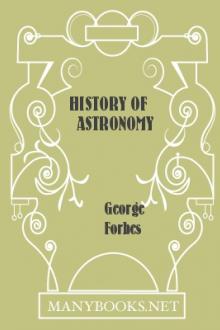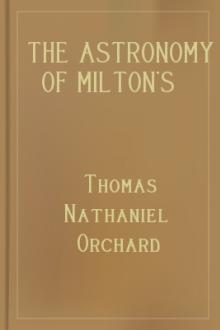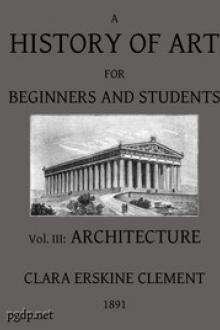History of Astronomy by George Forbes (classic children's novels TXT) 📕

- Author: George Forbes
- Performer: -
Book online «History of Astronomy by George Forbes (classic children's novels TXT) 📕». Author George Forbes
The same subject was again proposed for a prize which was shared by Lagrange [1] and Euler, neither finding a solution, while the latter asserted the existence of a resisting medium in space.
Again, in 1774, the Academy submitted the same subject, a third time, for the prize; and again Lagrange failed to detect a cause in gravitation.
Laplace [2] now took the matter in hand. He tried the effect of a non-instantaneous action of gravity, to no purpose. But in 1787 he gave the true explanation. The principal effect of the sun on the moon’s orbit is to diminish the earth’s influence, thus lengthening the period to a new value generally taken as constant. But Laplace’s calculations showed the new value to depend upon the excentricity of the earth’s orbit, which, according; to theory, has a periodical variation of enormous period, and has been continually diminishing for thousands of years. Thus the solar influence has been diminishing, and the moon’s mean motion increased. Laplace computed the amount at 10” in one century, agreeing with observation. (Later on Adams showed that Laplace’s calculation was wrong, and that the value he found was too large; so, part of the acceleration is now attributed by some astronomers to a lengthening of the day by tidal friction.)
Another contribution by Halley to the verification of Newton’s law was made when he went to St. Helena to catalogue the southern stars. He measured the change in length of the second’s pendulum in different latitudes due to the changes in gravity foretold by Newton.
Furthermore, he discovered the long inequality of Jupiter and Saturn, whose period is 929 years. For an investigation of this also the Academy of Sciences offered their prize. This led Euler to write a valuable essay disclosing a new method of computing perturbations, called the instantaneous ellipse with variable elements. The method was much developed by Lagrange.
But again it was Laplace who solved the problem of the inequalities of Jupiter and Saturn by the theory of gravitation, reducing the errors of the tables from 20’ down to 12”, thus abolishing the use of empirical corrections to the planetary tables, and providing another glorious triumph for the law of gravitation. As Laplace justly said: “These inequalities appeared formerly to be inexplicable by the law of gravitation—they now form one of its most striking proofs.”
Let us take one more discovery of Halley, furnishing directly a new triumph for the theory. He noticed that Newton ascribed parabolic orbits to the comets which he studied, so that they come from infinity, sweep round the sun, and go off to infinity for ever, after having been visible a few weeks or months. He collected all the reliable observations of comets he could find, to the number of twenty-four, and computed their parabolic orbits by the rules laid down by Newton. His object was to find out if any of them really travelled in elongated ellipses, practically undistinguishable, in the visible part of their paths, from parabolæ, in which case they would be seen more than once. He found two old comets whose orbits, in shape and position, resembled the orbit of a comet observed by himself in 1682. Apian observed one in 1531; Kepler the other in 1607. The intervals between these appearances is seventy-five or seventy-six years. He then examined and found old records of similar appearance in 1456, 1380, and 1305. It is true, he noticed, that the intervals varied by a year and a-half, and the inclination of the orbit to the ecliptic diminished with successive apparitions. But he knew from previous calculations that this might easily be due to planetary perturbations. Finally, he arrived at the conclusion that all of these comets were identical, travelling in an ellipse so elongated that the part where the comet was seen seemed to be part of a parabolic orbit. He then predicted its return at the end of 1758 or beginning of 1759, when he should be dead; but, as he said, “if it should return, according to our prediction, about the year 1758, impartial posterity will not refuse to acknowledge that this was first discovered by an Englishman.”[3] [_Synopsis Astronomiae Cometicae_, 1749.]
Once again Halley’s suggestion became an inspiration for the mathematical astronomer. Clairaut, assisted by Lalande, found that Saturn would retard the comet 100 days, Jupiter 518 days, and predicted its return to perihelion on April 13th, 1759. In his communication to the French Academy, he said that a comet travelling into such distant regions might be exposed to the influence of forces totally unknown, and “even of some planet too far removed from the sun to be ever perceived.”
The excitement of astronomers towards the end of 1758 became intense; and the honour of first catching sight of the traveller fell to an amateur in Saxony, George Palitsch, on Christmas Day, 1758. It reached perihelion on March 13th, 1759.
This fact was a startling confirmation of the Newtonian theory, because it was a new kind of calculation of perturbations, and also it added a new member to the solar system, and gave a prospect of adding many more.
When Halley’s comet reappeared in 1835, Pontecoulant’s computations for the date of perihelion passage were very exact, and afterwards he showed that, with more exact values of the masses of Jupiter and Saturn, his prediction was correct within two days, after an invisible voyage of seventy-five years!
Hind afterwards searched out many old appearances of this comet, going back to 11 B.C., and most of these have been identified as being really Halley’s comet by the calculations of Cowell and Cromellin[4] (of Greenwich Observatory), who have also predicted its next perihelion passage for April 8th to 16th, 1910, and have traced back its history still farther, to 240 B.C.
Already, in November, 1907, the Astronomer Royal was trying to catch it by the aid of photography.
FOOTNOTES:
[1] Born 1736; died 1813.
[2] Born 1749; died 1827.
[3] This sentence does not appear in the original memoir communicated to the Royal Society, but was first published in a posthumous reprint.
[4] R. A. S. Monthly Notices, 1907-8.
9. DISCOVERY OF NEW PLANETS—HERSCHEL, PIAZZI, ADAMS, AND LE VERRIER.
It would be very interesting, but quite impossible in these pages, to discuss all the exquisite researches of the mathematical astronomers, and to inspire a reverence for the names connected with these researches, which for two hundred years have been establishing the universality of Newton’s law. The lunar and planetary theories, the beautiful theory of Jupiter’s satellites, the figure of the earth, and the tides, were mathematically treated by Maclaurin, D’Alembert, Legendre, Clairaut, Euler, Lagrange, Laplace, Walmsley, Bailly, Lalande, Delambre, Mayer, Hansen, Burchardt, Binet, Damoiseau, Plana, Poisson, Gauss, Bessel, Bouvard, Airy, Ivory, Delaunay, Le Verrier, Adams, and others of later date.
By passing over these important developments it is possible to trace some of the steps in the crowning triumph of the Newtonian theory, by which the planet Neptune was added to the known members of the solar system by the independent researches of Professor J.C. Adams and of M. Le Verrier, in 1846.
It will be best to introduce this subject by relating how the eighteenth century increased the number of known planets, which was then only six, including the earth.
On March 13th, 1781, Sir William Herschel was, as usual, engaged on examining some small stars, and, noticing that one of them appeared to be larger than the fixed stars, suspected that it might be a comet. To test this he increased his magnifying power from 227 to 460 and 932, finding that, unlike the fixed stars near it, its definition was impaired and its size increased. This convinced him that the object was a comet, and he was not surprised to find on succeeding nights that the position was changed, the motion being in the ecliptic. He gave the observations of five weeks to the Royal Society without a suspicion that the object was a new planet.
For a long time people could not compute a satisfactory orbit for the supposed comet, because it seemed to be near the perihelion, and no comet had ever been observed with a perihelion distance from the sun greater than four times the earth’s distance. Lexell was the first to suspect that this was a new planet eighteen times as far from the sun as the earth is. In January, 1783, Laplace published the elliptic elements. The discoverer of a planet has a right to name it, so Herschel called it Georgium Sidus, after the king. But Lalande urged the adoption of the name Herschel. Bode suggested Uranus, and this was adopted. The new planet was found to rank in size next to Jupiter and Saturn, being 4.3 times the diameter of the earth.
In 1787 Herschel discovered two satellites, both revolving in nearly the same plane, inclined 80° to the ecliptic, and the motion of both was retrograde.
In 1772, before Herschel’s discovery, Bode[1] had discovered a curious arbitrary law of planetary distances. Opposite each planet’s name write the figure 4; and, in succession, add the numbers 0, 3, 6, 12, 24, 48, 96, etc., to the 4, always doubling the last numbers. You then get the planetary distances.
Mercury, dist.— 4 4 + 0 = 4 Venus ” 7 4 + 3 = 7 Earth ” 10 4 + 6 = 10 Mars ” 15 4 + 12 = 16
— 4 + 24 = 28
Jupiter dist. 52 4 + 48 = 52 Saturn ” 95 4 + 96 = 100 (Uranus) ” 192 4 + 192 = 196
— 4 + 384 = 388
All the five planets, and the earth, fitted this rule, except that there was a blank between Mars and Jupiter. When Uranus was discovered, also fitting the rule, the conclusion was irresistible that there is probably a planet between Mars and Jupiter. An association of twenty-four astronomers was now formed in Germany to search for the planet. Almost immediately afterwards the planet was discovered, not by any member of the association, but by Piazzi, when engaged upon his great catalogue of stars. On January 1st, 1801, he observed a star which had changed its place the next night. Its motion was retrograde till January 11th, direct after the 13th. Piazzi fell ill before he had enough observations for computing the orbit with certainty, and the planet disappeared in the sun’s rays. Gauss published an approximate ephemeris of probable positions when the planet should emerge from the sun’s light. There was an exciting hunt, and on December 31st (the day before its birthday) De Zach captured the truant, and Piazzi christened it Ceres.
The mean distance from the sun was found to be 2.767, agreeing with the 2.8 given by Bode’s law. Its orbit was found to be inclined over 10° to the ecliptic, and its diameter was only 161 miles.
On March 28th, 1802, Olbers discovered a new seventh magnitude star, which turned out to be a planet resembling Ceres. It was called Pallas. Gauss found its orbit to be inclined 35° to the ecliptic, and to cut the orbit of Ceres; whence Olbers considered that these might be fragments of a broken-up planet. He then commenced a search for other fragments. In 1804 Harding discovered Juno, and in 1807 Olbers found Vesta. The next one was not discovered until 1845, from which date asteroids, or minor planets (as these small planets are called), have been found almost every year. They now number about 700.
It is impossible to give any idea of the interest with which





Comments (0)